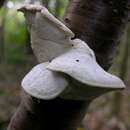tr
kırıntılardaki isimler


Postia tephroleuca, also known as greyling bracket,[1] is a species of fungus in the family Fomitopsidaceae infecting broad-leaved trees, typically beech and plane.
Postia tephroleuca, also known as greyling bracket, is a species of fungus in the family Fomitopsidaceae infecting broad-leaved trees, typically beech and plane.
Postia tephroleuca (Fr.) Jülich, Persoonia 11(4): 424 (1982)[1], è un fungo basidiomicete.
De asgrauwe kaaszwam (Postia tephroleuca) is een zwam uit de familie van de Fomitopsidaceae. In Nederland en België komt de soort algemeen voor.
De wetenschappelijke naam is voor het eerst gepubliceerd in 1821 door Elias Magnus Fries als de Polyporus tephroleucus. In 1827 werd de soort door Kurt Sprengel echter in het geslacht Boletus geplaatst. In 1886 werd de soort opnieuw tot een ander geslacht gerekend, deze keer tot het geslacht Leptoporus door Lucien Quélet. In de tussenliggende jaren is de soort meerdere malen van wetenschappelijke naam veranderd. In 1888 rekende Petter Adolf Karsten de soort weer tot het geslacht Bjerkandera. In datzelfde jaar werd de soort door Pier Andrea Saccardo wederom ingedeeld bij het geslacht Polyporus. In 1890 werd de soort weer ingedeeld onder het geslacht Bjerkandera, ditmaal onder de wetenschappelijke naam Bjerkandera cinerata door Petter Adolf Karsten. In 1933 schoof de soort nogmaals door, deze keer naar het geslacht Tyromyces. In 1982 schoof de soort door tot het geslacht Postia onder de wetenschappelijke naam Postia tephroleuca. Sinds 1985 wordt de Asgrauwe kaaszwam gerekend tot het geslacht Oligoporus onder de naam Oligoporus tephroleucus. Er is geen consensus of Oligoporus tephroleucus of Postia tephroleuca de geaccepteerde wetenschappelijke naam is.[1][2]
Het vruchtlichaam is eenjarig en heeft een knolachtige vorm. De hoed is tussen de 4 en de 10 centimeter lang, tussen de 2 en 5 centimeter breed en is 2 tot 4 centimeter dik en heeft een scherpe rand. De bovenkant van de hoed heeft een gladde tot licht viltige textuur en heeft een witachtige kleur die kan variëren van wit tot grijsgeel tot grijsbruin. De buisjes zijn tussen de 6 en de 10 millimeter land en hebben een witte kleur. De sporen hebben een witte kleur, net zoals het vlees. De poriën hebben een witte kleur en zijn rond tot hoekig van vorm. Tussen de poriën zit een afstand van tussen de 4 en de 5 millimeter.[3]
De soort is een saprofiet die leeft op boomstammen van loofbomen onder andere van de eik, de berk en de es. De soort komt voornamelijk voor in Europa maar ook in Japan. Sporadisch wordt de Asgrauwe kaaszwam langs de kust in de Verenigde-Staten waargenomen en op een enkele plek in Rusland.[4]
Bronnen, noten en/of referentiesDe asgrauwe kaaszwam (Postia tephroleuca) is een zwam uit de familie van de Fomitopsidaceae. In Nederland en België komt de soort algemeen voor.
Cost capìtol a l'é mach në sbòss. Da finì.
A chërs an dzora a suche e bion ëd latifeuje, pì da rair ëd conìfere.
![]() A venta mai mangé un bolè trovà se un a l'é nen un bon conossidor dij bolè!
A venta mai mangé un bolè trovà se un a l'é nen un bon conossidor dij bolè!
As peul nen mangesse.
Oligoporus tephroleucus (Fr.) Gilb. & Ryvarden
Cost capìtol a l'é mach në sbòss. Da finì.
AmbientA chërs an dzora a suche e bion ëd latifeuje, pì da rair ëd conìfere.
Comestibilità![]() A venta mai mangé un bolè trovà se un a l'é nen un bon conossidor dij bolè!
A venta mai mangé un bolè trovà se un a l'é nen un bon conossidor dij bolè!
As peul nen mangesse.
Drobnoporek mleczny (Postia tephroleuca (Fr.) Jülich) – gatunek grzybów z rodziny pniarkowatych (Fomitopsidaceae)[1].
Pozycja w klasyfikacji: Postia, Fomitopsidaceae, Polyporales, Incertae sedis, Agaricomycetes, Agaricomycotina, Basidiomycota, Fungi[1].
Po raz pierwszy takson ten zdiagnozował w 1821 r. Elias Fries nadając mu nazwę Polyporus tephroleucus. Obecną, uznaną przez Index Fungorum nazwę nadał mu w 1982 r. Walter Jülich, przenosząc go do rodzaju Postia[1].
Synonimów naukowych jest 22. Niektóre z nich[2]:
Nazwę polską podał Władysław Wojewoda w 2003 r., przez S. Domańskiego gatunek ten opisywany był jako białak mleczny lub białak popielaty[3].
Jednoroczna huba o mięsistej konsystencji. Do podłoża przyrasta bokiem. Owocniki wyrastają pojedynczo lub w nielicznych skupiskach. Pojedynczy ma średnicę do 10 cm i grubość do 4 cm, brzeg ostry[4]. Kształt wachlarzowaty, konsolowaty lub półkolisty. Skórka zbudowana jest ze strzępek o żelatynowej konsystencji, początkowo promieniście włókienkowata, później gładka, czasami nierówna i guzkowata. Barwa górnej powierzchni kapelusza początkowo biała, później szarobiaława, popielatoszarawa i rogowoszarawa. Wysychając żółknie[5].
Rurkowaty, znajduje się na dolnej stronie owocnika. Rurki mają długość 3-8 mm, ich pory są bardzo drobne, okrągławe lub wydłużone. Mają średnicę 0,15-0-6 mm (na 1 mm mieści się ich zazwyczaj 4-6). Hymenofor jest białawy i tylko na porozrywanych brzegach żółtawy[5].
Miękki, mięsisty, biały i nie zmieniający barwy po uszkodzeniu. Nie posiada zapachu, smak łagodny, czasami kwaskowaty[5].
System strzępkowy monomityczny. Strzępki kontekstu cienkościenne lub umiarkowanie grubościenne, z licznymi przegrodami, niektóre gęsto rozgałęzione. Mają szerokość 3–8 μm. Strzępki tramy głównie cienkościenne, o szerokości 2–4 μm, ze sprzążkami. Brak cystyd i innych płonych elementów hymenium. Podstawki zgrubiałe, 4–sterygmowe, o rozmiarach 14–16 × 4–5 μm ze sprzążkami w podstawie. Zarodniki cylindryczne, lekko zakrzywione, bezbarwne, gładkie, nieamyloidalne, o rozmiarach 4,5–6 × 1–1,5 μm[6].
Notowany jest w Ameryce Północnej, Azji i Europie – tutaj najliczniej[7]. W Polsce podano wiele jego stanowisk w piśmiennictwie naukowym. Według W. Wojewody nie jest zagrożony[3].
Występuje na martwym drewnie drzew iglastych i liściastych, szczególnie na brzozie brodawkowanej, buku, olszy i jodle. Owocniki wyrastają od sierpnia do października[3].
Grzyb niejadalny. Jest saprotrofem rozwijającym się na martwym drewnie[5]. Powoduje brunatną zgniliznę drewna[6].
Jest kilka bardzo podobnych morfologicznie grzybów o białym owocniku i mięsistej konsystencji.
Drobnoporek mleczny (Postia tephroleuca (Fr.) Jülich) – gatunek grzybów z rodziny pniarkowatych (Fomitopsidaceae).